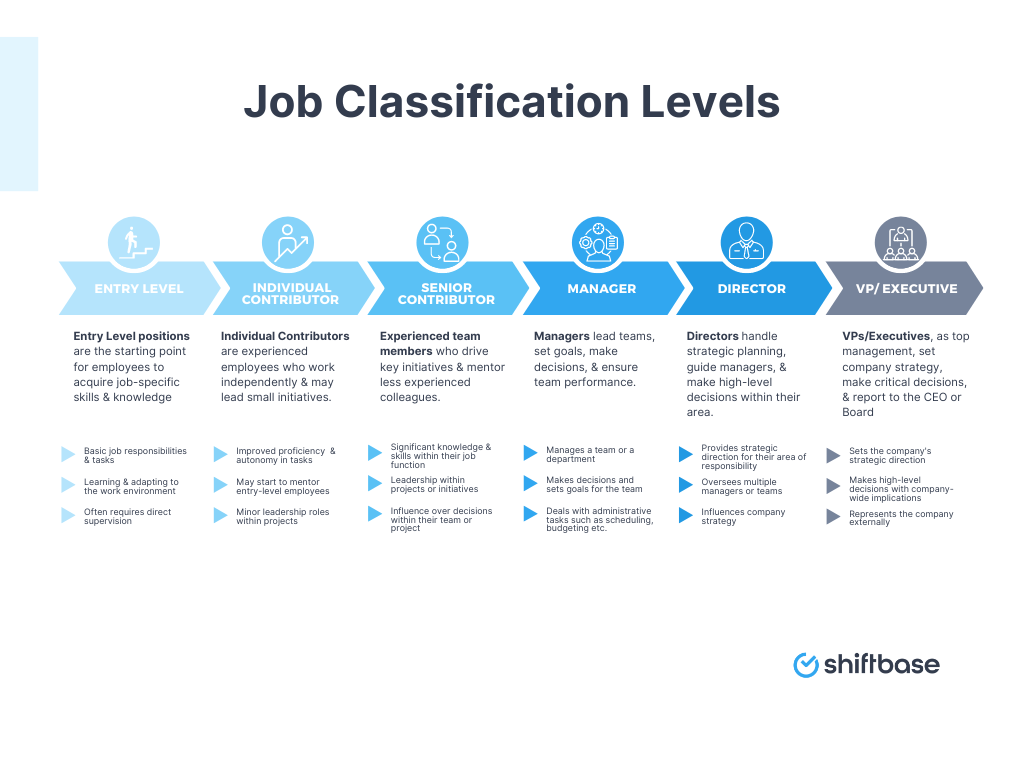What is job classification?
Job classification is a fundamental component of HR, providing a structured framework for categorizing jobs within an organization.
It involves analyzing job responsibilities, skills, and required knowledge to create job descriptions and assign appropriate job titles.
By classifying jobs, organizations can establish a systematic process for determining compensation, facilitating career development, and ensuring internal equity.
At its core, the job classification method aims to group similar jobs based on their shared characteristics. This grouping allows organizations to establish clear and consistent job structures that form the basis for various HR functions, including:
- Compensation management
- Career progression
- Organizational development
Through job classification, organizations can define the essential elements of each position and create comprehensive job descriptions that outline the job duties, responsibilities, and required qualifications.
These job descriptions are valuable for recruitment, employee selection, and performance management processes.
Useful read: The 6 top Employee Performance Management Trends of 2023
Furthermore, job classification plays a crucial role in determining compensation levels.
By grouping jobs into categories or levels, organizations can establish pay ranges that reflect each position's complexity, responsibility, and required skills.
This ensures that employees are fairly compensated for their contributions and helps maintain internal equity within the organization.
How does job classification work?

Job classification follows a systematic process that begins with analysis. The analysis involves gathering information about various job functions and aspects, including the
This information is then used to create detailed job descriptions that provide a comprehensive overview of each position within the organization.
Once a job description is established, jobs are grouped into categories or job families based on similarities in required skills, responsibilities, and organizational levels.
These categories form the foundation of the job classification system, allowing organizations to create a consistent and logical structure for their workforce.
Organizations may adopt different classification structures tailored to their specific needs. One popular approach is the broadband pay structure, which groups jobs into broader pay bands based on their levels of responsibility and required skills.
This structure provides flexibility in compensation management and allows for more fluid career progression within broader job categories.
Another commonly used job classification system is the Korn Ferry Hay System, which assesses jobs based on the required;
- Knowledge
- Problem-solving abilities
- And accountability
The system assigns points to each job, determining its level within the organization and facilitating a better understanding of job levels and their corresponding compensation ranges.
What are the benefits from job classification?
The results of job classification have numerous benefits for both employers and employees. Let's explore how job classification impacts organizations and their workforce:
-
For employers, job classification provides a structured framework for determining compensation. Organizations can establish internal equity by assigning jobs to specific levels or pay bands and ensuring that employees are fairly compensated based on their responsibilities and skill levels.
-
Job classification facilitates organizational development processes by identifying skill gaps within the workforce. This valuable insight allows employers to design targeted training and development programs that address these gaps and enhance employee skills. It also enables organizations to make informed decisions about promotions, transfers, and departmental reorganizations, as job classification provides a clear understanding of job levels and responsibilities.
-
Job classification brings transparency and clarity to job requirements and expectations, benefiting employees. It helps individuals understand their roles and responsibilities within the organization, setting clear guidelines for performance expectations. Moreover, job classification establishes well-defined career paths, allowing employees to see the progression opportunities available based on their current job classification.
-
Fair compensation structures resulting from job classification promote employee satisfaction and engagement. Employees who see that their compensation aligns with their work responsibilities and skill levels are more likely to feel valued and motivated.
Salary administration and job classification
Salary administration is a critical aspect of job classification, as it involves determining the appropriate pay range and compensation for each job category or level.
Once jobs are classified into specific groups or pay bands based on their responsibilities and required qualifications, organizations can establish payment ranges that provide guidelines for compensation.
Establishing salary ranges involves considering various factors, including job duties and responsibilities alone, market conditions, industry standards, and the organization's budget.
By considering these factors, organizations can ensure that employees are fairly compensated for their contributions and that their salaries align with market trends.
However, salary ranges are not static. They must be regularly reviewed and adjusted to account for changes in economic conditions, inflation rates, and market competitiveness.
Annual salary range adjustments are often made to maintain the organization's ability to attract and retain talent while ensuring that compensation remains competitive and equitable.
During these adjustments, organizations may consider factors such as overall financial health, budget considerations, and the need to attract and retain high-performing employees.
These adjustments help ensure that compensation remains aligned with industry standards and that employees' salaries reflect their contributions and the value they bring to the organization.
Furthermore, salary administration is crucial in fostering employee satisfaction and motivation.
Employees who perceive their compensation as fair and competitive are more likely to feel valued and motivated.
It creates a sense of equity and recognition, contributing to a positive work environment and enhancing employee engagement.
Organizations that effectively administer salaries based on job classification also demonstrate a commitment to maintaining internal equity. By establishing and adhering to salary ranges, organizations ensure that employees in similar job categories or levels receive comparable compensation, regardless of personal factors. This promotes fairness and reduces the risk of salary disparities within the organization.
Other job classification structures and systems
While the broadband and pay grade structure and the Korn Ferry Hay System are widely recognized and utilized approaches to job classification, it's essential to acknowledge that organizations can develop unique classification structures and systems.
These customized structures and systems can be tailored to meet each organization and industry's needs and requirements.
Organizations may incorporate additional factors and considerations into their classification structures beyond those provided by existing approaches.
For example,
Job complexity can be critical in determining job classifications.
Roles that involve intricate problem-solving, strategic decision-making, or extensive project management may be classified differently from those with more routine or repetitive tasks. This differentiation allows organizations to appropriately reward and recognize the complexity and skill required for different positions.
Another factor that organizations may consider in their job classification structures is the level of customer interaction. Jobs that involve direct customer service or client management responsibilities may have distinct classifications to reflect the importance of customer relationship management and the specific skills required to handle customer interactions effectively.
Technical expertise is another aspect that organizations may incorporate into their classification structures. Positions requiring specialized technical skills like software development, engineering, or scientific research may be classified differently from other jobs to acknowledge the unique expertise and qualifications needed for those roles.
It is crucial to recognize that job classification is a dynamic process that should adapt to the evolving needs of organizations.
As businesses grow, industries change, and new technologies emerge, job roles and responsibilities may evolve. Therefore, regular evaluations and updates to job classifications are essential to ensure they remain relevant and reflect the changing nature of work.
Organizations should conduct periodic reviews of job classifications to ensure they align with industry trends, market demands, and evolving job requirements. This includes evaluating job titles, position descriptions, and associated skill requirements to capture the essence of each position within the organization accurately.
What are job classification levels?

Job levels are hierarchical categories within an organization that define positions' relative seniority, responsibilities, and authority. They provide a framework for understanding the
organizational structure and the progression opportunities available to employees.
Job levels are typically structured hierarchically, with higher levels representing positions of greater authority, responsibility, and decision-making power. These levels often align with different stages of career progression and are used to differentiate classes based on their scope, complexity, and impact within the organization.
The number of job levels within an organization can vary based on size, industry, and organizational structure. Larger organizations tend to have more extensive job levels to accommodate a broader range of positions and facilitate career advancement.
The specific names or titles given to job levels may vary across organizations, but they generally follow a similar progression pattern. Common examples of job levels include;
Entry-level positions
Entry-level positions are typically the starting point for individuals embarking on their professional careers. These positions require minimal experience or specialized skills and provide opportunities for individuals to gain foundational knowledge and skills in their respective fields.
Entry-level roles often involve learning from more experienced team members and contributing to employees' growth and development.
Individual contributor
The individual contributor level represents employees who have progressed beyond entry-level positions and developed expertise in their respective domains. These individuals are often subject matter experts and contribute significantly to the organization's projects, tasks, and deliverables.
Individual contributors demonstrate a high level of proficiency in their roles and may serve as mentors or resources for junior team members.
Senior contributor:
Senior contributors have attained higher mastery and experience than individual contributors. They possess in-depth knowledge, advanced skills, and a track record of consistently delivering high-quality work.
Senior contributors often take on more complex and strategic assignments, mentor junior team members, and provide guidance and expertise within their areas of specialization.
Manager
The manager level represents a significant shift in responsibilities. Managers are responsible for overseeing a team or department, guiding their direct reports, and ensuring that work is completed efficiently and effectively.
They provide leadership, make decisions, and play a crucial role in coordinating and aligning the efforts of their team members to achieve organizational objectives. Managers are responsible for the management and goal setting and often liaise between their team and upper management.
Director
Directors hold higher authority and responsibility within an organization. They typically oversee multiple teams, departments, or functional areas and are accountable for achieving strategic goals and driving organizational success.
Directors collaborate with other leaders, provide strategic direction, and make critical decisions that impact the overall direction of their respective areas of responsibility.
VP/Executive
The VP/Executive level represents the highest leadership level within an organization. These individuals are responsible for setting the company's vision, strategic goals, and overall direction.
They have a broad scope of influence and play a significant role in shaping the organization's culture, driving innovation, and ensuring long-term success. VPs and executives often collaborate with the board of directors, significantly impacting the organization's strategic decision-making processes.
Each job level represents a different stage in an individual's career progression and entails increasing;
- Levels of responsibility
- Decision-making authority
- Leadership
Advancement from one level to another is typically based on experience, expertise, demonstrated performance, and organizational need. Job levels provide a clear structure for career growth, compensation progression, and opportunities for professional development within an organization.
Useful Read: Weighing the Pros and Cons of Performance-Related Pay
Job levels serve multiple purposes within an organization:
Career progression:
Levels provide employees with a clear understanding of the progression opportunities within the organization. Employees can aspire to progress through the levels by gaining experience, developing skills, and demonstrating their capabilities.
Compensation and rewards:
They often play a significant role in determining compensation structures. Higher levels typically correspond to higher salary ranges, reflecting the increased responsibilities and expertise required for those positions. Levels also influence rewards and employee benefits, such as bonuses, incentives, and promotional opportunities.
Organizational structure and reporting relationships:
Job levels help establish the organizational structure and reporting relationships within the job family of the organization. They define the hierarchy of authority and establish the lines of supervision and accountability.
Succession planning and talent management:
They enable organizations to identify high-potential employees and plan for future leadership positions. By understanding the skills and experiences required for each job level, organizations can develop talent pipelines and succession plans to ensure a smooth transition of critical roles and responsibilities.
It's important to note that job levels are not solely determined by job titles or formal rank. Factors such as job responsibilities, decision-making authority, and scope of influence are also crucial in defining job levels. Job classification systems, such as the Korn Ferry Hay System, often incorporate job levels as a critical component in evaluating and categorizing organizational positions.

Employee scheduling and Time-tracking software!
How to implement job levels
When the time comes to change or better define work levels within your company, it is important to approach the process thoughtfully and strategically. Implementing job levels involves several key steps to ensure a smooth transition and effective alignment with your organization's needs. Let's explore the process of implementing job levels:
Assemble a team
The first step is assembling a team of human resources professionals and other leaders within the company to help you design a new structure. This team should deeply understand your organization's goals, culture, and industry dynamics. Collaborating with diverse perspectives can lead to more comprehensive and well-rounded job-level design.
Assess the current structure
Assess your organization's current job structure and hierarchy with the team. Understand each department or functional area's roles, responsibilities, and reporting relationships. Identify any inconsistencies or gaps in the current job levels that may hinder clarity or career progression.
Define desired job levels
Working collaboratively, define the desired job levels that align with your organization's structure, culture, and future growth plans. Consider the number and hierarchy of job levels that balance offering meaningful career progression opportunities and maintaining a manageable scale. Ensure the job levels align with the skills and competencies required for each position.
Develop clear criteria
Establish clear criteria and guidelines for each job level. Define each level's qualifications, responsibilities, decision-making authority, and leadership requirements. This clarity ensures consistency and fairness in the placement of employees within the job structure.
Conduct job analysis and evaluation
Conduct a comprehensive work analysis and evaluation for each position within your organization. Evaluate each role's responsibilities, required skills, and competencies to determine the appropriate job-level placement. This analysis may involve gathering input from employees, managers, and subject matter experts and reviewing industry benchmarks and best practices.
Communicate the changes
Transparent and effective communication is crucial when implementing job levels. Communicate the reasons for the change, its benefits to employees and the organization, and how it aligns with your strategic objectives. Address employees' concerns or questions and provide opportunities for feedback and discussion. Engage employees in the process to foster a sense of ownership and understanding.
Useful Read: Change Management Strategy: Definitions + development plan
Review and revise job descriptions
Review and revise job descriptions to align them with the new job levels. Ensure that each job title and description accurately reflect the responsibilities, skills, and qualifications of the individual job level. This process helps establish clarity and consistency in role expectations and facilitates effective performance management and career development.
Establish transition plans
Develop transition plans to guide employees through the implementation of job levels. Provide clear guidelines on how existing employees will be transitioned to the new job levels, including any necessary training or development opportunities to support their growth. Consider any potential impacts on compensation, benefits, and career advancement opportunities during the transition period.
Monitor and evaluate
Regularly monitor and evaluate the effectiveness of the implemented job levels. Solicit feedback from employees and managers to assess the clarity and fairness of the structure. Adjust as needed to address any emerging issues or changes in organizational needs. Continuous evaluation and refinement ensure that the job levels remain relevant and support your organization's goals.
By following these steps and engaging key stakeholders in the process, you can effectively implement job levels that support career growth, provide clarity and fairness, and align with your organization's strategic objectives. A well-designed job structure sets the foundation for employee development, talent management, and organizational success.
Conclusion
Job classification forms the foundation of effective human resources management. Organizations can establish fair and consistent compensation systems by using job evaluation methods, systematically categorizing jobs based on similarities, facilitating career development, and promoting employee satisfaction. Understanding the principles and processes of job classification is essential for organizations aiming to optimize their workforce management practices and create a cohesive and engaged workforce.


 Job levels are hierarchical categories within an organization that define positions' relative seniority, responsibilities, and authority. They provide a framework for understanding the
Job levels are hierarchical categories within an organization that define positions' relative seniority, responsibilities, and authority. They provide a framework for understanding the 

